
The Caprioli Chapel is the second chapel on the left side of the nave of the Church of San Giorgio in Brescia.

The Caprioli Chapel is the second chapel on the left side of the nave of the Church of San Giorgio in Brescia.
The original chapels in the northern nave of the church can be placed in the time following the 13th century foundation of the building, but likely they stem from the fifteenth century. The owners of the second chapel in the counterfacade were the powerful Brescian family of Caprioli. The first arrangement of the chapel according to the new ornamental taste of the period probably dates back to the 1450s: the work was perhaps entrusted to the Sanmicheli workshop, very popular in the city after the erection of the innovative façade of the Church of Santa Maria dei Miracoli, while the funeral monument of Luigi Caprioli dating to 1494, executed by Gasparo Cairano, is installed within. The sculptural outfit of the chapel was completed by at least a figured altarpiece depicting a Madonna with Child among the saints Joseph and Catherine. [1]
During the seventeenth century, the chapel was reorganised along baroque lines, with a new roofing dome built with a lantern. In 1805, the church and the adjoining Franciscan monastery were closed; just before that, the tomb of Luigi Caprioli was dismantled. Its relief, the Caprioli Adoration, ended up in the high altar at the Church of St Francis of Assisi in Brescia, where it is today. [1] The paintings in the chapel were moved to the Diocesan Museum of Brescia. Following the total renovation of the church in 2010, the chapel houses exhibition panels on the history and architectural elements of the church.
The chapel is presented in the 17th century Baroque style, with large panel frescoes in ultramarine and a luminous dome. The altar, of considerable size, is of the same period and inlaid with multicoloured marble, and presents a figurative front. However, the environs are devoid of furniture just as the altar is bare of decoration.
The outer lines of the chapel are worked with fine marble carvings that go up along its arch like a candelabra. This is attributed to the Sanmicheli studio, representing the last remnants of the substantial stone structure that decorated the chapel at the end of the 15th century. [1]
Removed from the chapel, as mentioned earlier, is the Caprioli Adoration, among the masterpieces of Gasparo Cairano. Within the chapel it is possible to place a marble fragment with its ornamental reliefs and bearing the Caprioli coat of arms, now preserved in the sacristy of the church. [1]
The marble altarpiece comprising a Madonna and Child between the saints Joseph and Catherine that adorned the chapel can, according to Bernardino Faino, be traced back to the same master who implemented the chapel ornamentation, namely Gasparo Cairano. [2] Only one other item of this type is known by Cairano, the Kress Altar, currently in the National Gallery of Art in Washington, D.C. [3]
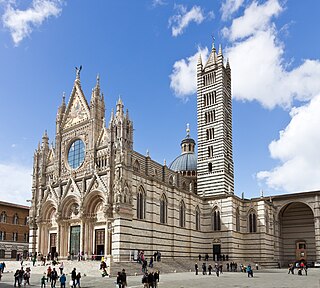
Siena Cathedral is a medieval church in Siena, Italy, dedicated from its earliest days as a Roman Catholic Marian church, and now dedicated to the Assumption of Mary.
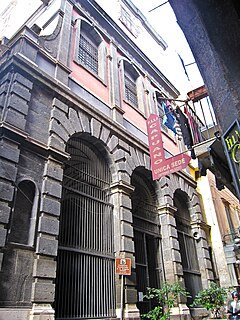
San Gregorio Armeno is a church and a monastery in Naples, Italy. It is one of the most important Baroque complexes in Naples. The church is located on a street of the same name just south of Via dei Tribunali and a few blocks south of the church of San Paolo Maggiore, Naples

Gesù Nuovo is the name of a church and a square in Naples, Italy. They are located just outside the western boundary of the historic center of the city. To the southeast of the spire, one can see a block away the Fountain of Monteoliveto and the piazza of the church of Sant'Anna dei Lombardi. The square is a result of the expansion of the city to the west beginning in the early 16th century under the rule of Spanish viceroy Pedro Alvarez de Toledo. The square of Gesù Nuovo contains three prominent landmarks:

The Basilica della Santissima Annunziata del Vastato is the Catholic cathedral of Genoa, northern Italy; its decoration employed the major baroque studios and artists in Genoa in the 17th century.

San Francesco della Vigna is a Roman Catholic church in the Sestiere of Castello in Venice, northern Italy.

The Madonna dell'Orto is a church in Venice, Italy, in the sestiere of Cannaregio.

The Basilica of San Domenico, also known as Basilica Cateriniana, is a basilica church in Siena, Tuscany, Italy, one of the most important in the city.

The Church of Nuestra Señora de la Asunción is a church and parish in Meco, Spain. The church was added to the Bien de Interés Cultural registry in 1982.

The church of Santa Maria dei Miracoli is located on Corso Vittorio Emanuele in Brescia.
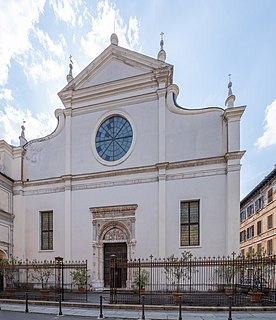
The church of Santa Maria delle Grazie in Brescia is located on at the west end of Via Elia Capriolo, where it intersects with the Via delle Grazie. Built in the 16th century and remodeled in the 17th century, it still retains much of its artwork by major regional artists, including one of its three canvases by Moretto. The other two are now held at the Pinacoteca Tosio Martinengo. The interior is richly decorated in Baroque fashion. Adjacent to the church is the Sanctuary of Santa Maria delle Grazie, a neo-gothic work.
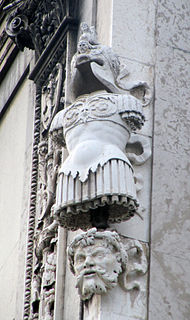
Gasparo Cairano, also known as Gasparo da Cairano, de Cayrano, da Milano, Coirano, and other variations, was an Italian sculptor of the Renaissance.
Antonio della Porta, better known as Tamagnino was an Italian sculptor of the Renaissance.
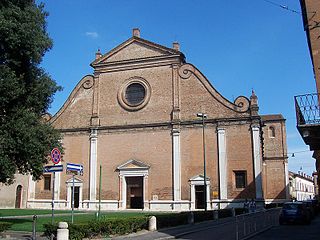
San Francesco is a late-Renaissance, Roman Catholic minor basilica church located on via Terranuova in Ferrara, Emilia-Romagna, Italy.

Santa Maria della Carità or just known as the Carità, or the church of the Buon Pastore, is a Baroque-style, Roman Catholic church located on Via dei Musei corner via Rosa in Brescia, region of Lombardy, Italy.

Santa Caterina d'Alessandria or Saint Catherine of Alexandria is a Roman Catholic church with a main facade on Piazza Bellini, and a lateral Western facade facing the elaborate Fontana Pretoria, in the historic quarter of Kalsa in the city of Palermo, region of Sicily, Italy. In front of the main facade, across the piazza Bellini, rise the older churches of San Cataldo and Santa Maria dell'Ammiraglio, while across Piazza Pretoria is the Theatine church of San Giuseppe and the entrance to the Quattro Canti. Refurbished over the centuries, the church retains elements and decorations from the Renaissance, Baroque, and late-Baroque (Rococo) eras. This church is distinct from the Oratorio di Santa Caterina found in the Olivella neighborhood.
The Caprioli Adoration is a Italian Renaissance sculpture, a relief in marble by Gasparo Cairano, dated between 1495 and 1500, placed in the Church of St Francis of Assisi in Brescia as a frontal for the high altar.

Maffeo Olivieri was an Italian sculptor and wood carver. Often associated with his younger brother Andrea, he was active in Lombardy, Venice and Trentino. He was known for his bronze, wood and marble creations, and considered the premier sculptor in early sixteenth century Brescia.

The Ark of Sant'Apollonio is a funerary monument in marble by Gasparo Cairano. Dated between 1508 and 1510, it is located in the third chapel on the right of the southern nave of the New Cathedral, Brescia.

The Ark of San Tiziano is a marble tomb attributed to the Sanmicheli studio. Finished in 1505, it is located in the Church of the Saints Cosma and Damiano in Brescia, in the chapel dedicated to these saints.
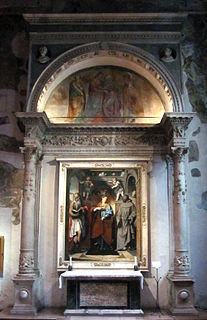
The Altar of San Girolamo is a sculptural complex in marble, around 780×450×80cm in dimension, designed and constructed by Gasparo Cairano and Antonio Medaglia, and situated within the Church of St Francis of Assisi in Brescia, Italy. Dated between 1506–1510, it is located in the first chapel on the right side of the nave.